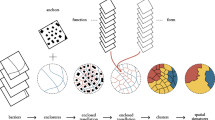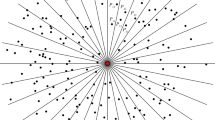Abstract
A spatial tessellation is a set of regions that are collectively exhaustive and mutually exclusive except for the boundaries. In geographical analysis, it may represent such administrative units as census tracts, postal zones, and electoral or school districts. Spatial tessellations of a certain area are often closely related to each other. Areas of local communities are related to school districts, market areas of retail stores, and administrative units. Postal zones and census tracts are determined by collecting or dividing administrative units. Analysis of such relations among tessellations often reveals their underlying spatial phenomena. To this end, this paper proposes a new exploratory method for analyzing the relations among spatial tessellations. It aims to detect spatial patterns, especially those with a hierarchical structure, and to provide a tessellation classification scheme. Topological relations and similarity measures are introduced to evaluate the relations between tessellation pair. For more tessellations, tree representations are proposed. These not only visualize relations, but also provide a means of classifying tessellations. The method is applied to the analysis of two sets of spatial tessellations: one with five hypothetical tessellations, and another with 34 candidate plans for the new Doshusei administrative system in Japan. The application reveals the properties of the method and quantitative measures used in analysis.










Similar content being viewed by others
References
Anderson I (2002) Combinatorics of finite sets. Dover Publications, New York
Andrews DS, Snoeyink J, Boritz J, Chan T, Denham G, Harrison J, Zhu C (1994) Further comparison of algorithms for geometric intersection problems. In: Proceedings of the 6th international symposium on spatial data handling, pp 709–724
Baum JD (1964) Elements of point set topology. Prentice Hall, Englewood Cliffs
Bentley JL, Ottmann TA (1979) Algorithms for reporting and counting geometric intersections. IEEE Trans Comput C-28:643–647
Berry BJL, Pred AR (1965) Central place studies: a bibliography of theory and applications. Regional Science Research Institute, Philadelphia
Bittner T, Smith B (2001) A taxonomy of granular partitions. In: Montello DR (ed) COSIT 2001, LNCS, vol 2205. Springer, Berlin, pp 28–43
Bittner T, Smith B (2003) A theory of granular partitions. In: Duckham M, Goodchild MF, Worboys MF (eds) Foundations of geographic information science. Taylor & Francis, London, pp 117–151
Boots B, Csillag F (2006) Categorical maps, comparisons, and confidence. J Geogr Syst 8:109–118
Christaller W (1933) Die zentralen orte in Suddeutschland. Gustav Fischer, Jena
Congalton RG, Mead RA (1983) A quantitative method to test for consistency and correctness in photointerpretation. Photogramm Eng Remote Sens 49:69–74
Davey BA, Priestley HA (2002) Introduction to lattice and order. Cambridge University Press, Cambridge
Egenhofer MJ, Franzosa RD (1991) Point set topological relations. Int J Geogr Inf Syst 5:161–174
Frank AU, Volta GS, McGrannaghan M (1997) Formalization of families of categorical coverages. Int J Geogr Inf Sci 11:215–231
Fritz S, See L (2005) Comparison of land cover maps using fuzzy agreement. Int J Geogr Inf Sci 19:787–807
Goodchild MF, Lam NN-S (1980) Areal interpolation: a variant of the traditional spatial problem. Geo-processing 1:297–312
Gratzer G (2009) Lattice theory. Dover Publications, New York
Grünbaum B, Shephard GC (1987) c. W. H. Freeman, New York
Kahn DW (1995) Topology: an introduction to the point-set and algebraic areas. Dover Publication, New York
Kraak M-J (2003) Cartography: visualization of geospatial data. Pearson Education, New York
Lam NN-S (1983) Spatial interpolation methods: a review. Am Cartogr 10:129–149
Monserud RA, Leemans R (1992) Comparing global vegetation maps with Kappa statistic. Ecol Model 62:275–293
Okabe A, Sadahiro Y (1996) An illusion of spatial hierarchy: spatial hierarchy in a random configuration. Environ Plan A 28:1533–1552
Okabe A, Boots B, Sugihara K, Chiu S-N (2000) Spatial tessellations—concepts and applications of Voronoi diagrams. Wiley, New York
Pemmaraju S, Skiena S (2003) Computational discrete mathematics: combinatorics and graph theory with mathematica. Cambridge University Press, New York
Pontius RG Jr (2000) Quantification error versus location error in comparison of categorical maps. Photogramm Eng Remote Sens 66:1011–1016
Pontius RG Jr (2002) Statistical methods to partition effects of quantity and location during comparison of categorical maps at multiple resolutions. Photogramm Eng Remote Sens 68:1041–1049
Preparata FP, Shamos MI (1985) Computational geometry: an introduction. Springer, New York
Rosenfield GH, Fitzpatrick-Lins K (1986) A coefficient of agreement as a measure of thematic classification accuracy. Photogramm Eng Remote Sens 52:223–227
Sadahiro Y (1999) Accuracy of areal interpolation: a comparison of alternative methods. J Geogr Syst 1:323–346
Sadahiro Y (2002) An exploratory method for analyzing a spatial tessellation in relation to a set of other spatial tessellations. Environ Plan A 34:1037–1058
Sadahiro Y, Sasaya T (2009) Analysis of the relationship among spatial tessellations. Discussion Paper Series, 96r1, Department of Urban Engineering, University of Tokyo
Sasaya T (2008) Methods for evaluating the similarity between tessellations. Master’s thesis, Department of Urban Engineering, University of Tokyo
Slocum TA, McMaster RB, Kessler FC, Howard HH (2004) Thematic cartography and geographic visualization. Prentice-Hall, Upper Saddle River
Acknowledgments
This paper is an extension of the master’s thesis of T. Sasaya completed under the author’s supervision (Sasaya 2008). Discussions with him were always stimulating and fruitful. The author would also like to thank A. Okabe, Y. Asami, and T. Ishikawa for their valuable comments.
Author information
Authors and Affiliations
Corresponding author
Rights and permissions
About this article
Cite this article
Sadahiro, Y. Analysis of the relations among spatial tessellations. J Geogr Syst 13, 373–391 (2011). https://doi.org/10.1007/s10109-010-0127-3
Received:
Accepted:
Published:
Issue Date:
DOI: https://doi.org/10.1007/s10109-010-0127-3




